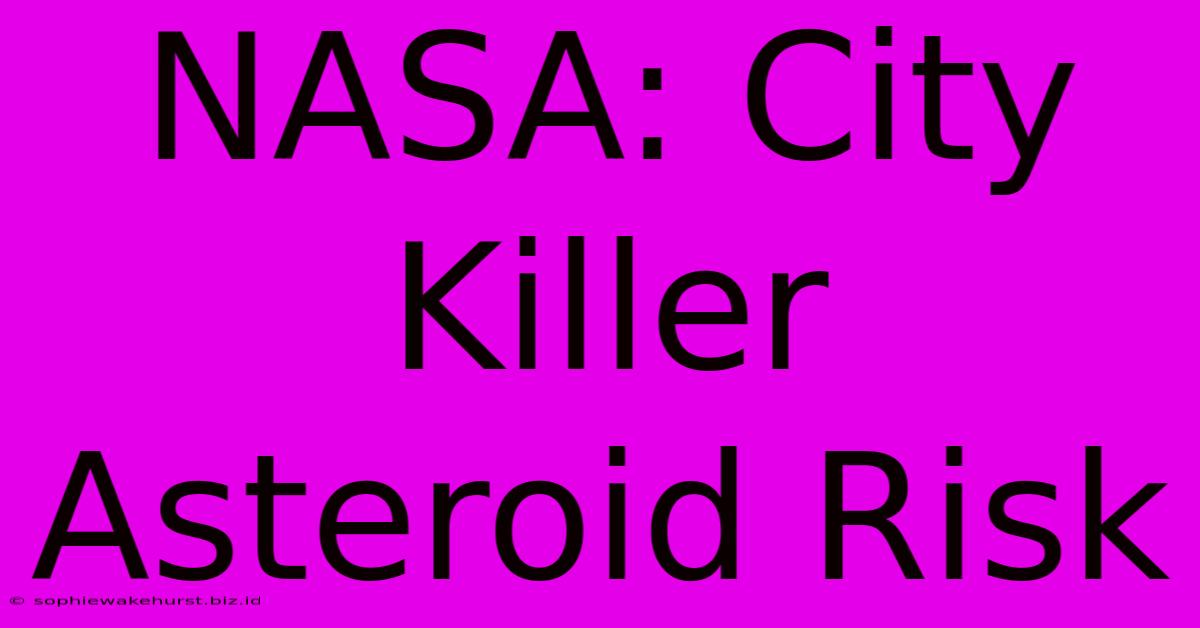NASA: City Killer Asteroid Risk

Discover more detailed and exciting information on our website. Click the link below to start your adventure: Visit Best Website. Don't miss out!
Table of Contents
NASA: The City-Killer Asteroid Risk – Are We Prepared?
The vast expanse of space holds breathtaking wonders, but it also harbors potential threats. Among them, asteroids pose a significant, albeit low-probability, risk to Earth. NASA and other space agencies worldwide are actively monitoring near-Earth objects (NEOs), focusing especially on those large enough to cause widespread devastation – the so-called "city-killers." This article explores the nature of this threat, NASA's efforts to mitigate it, and the ongoing challenges in planetary defense.
Understanding the Threat: City-Killer Asteroids
"City-killer" asteroids are typically defined as objects ranging from 140 to 1,000 meters in diameter. An impact from such an asteroid would not cause a global extinction event like the one that wiped out the dinosaurs, but the consequences would be catastrophic. The impact energy would be equivalent to many megatons of TNT, obliterating a large metropolitan area and causing significant regional damage through shockwaves, heat radiation, and tsunamis (for coastal impacts). The resulting dust and debris could also affect global climate patterns, albeit on a smaller scale than a larger impactor.
Identifying the Risk
NASA's Planetary Defense Coordination Office (PDCO) plays a crucial role in identifying and tracking NEOs. Using ground-based telescopes and space-based observatories, they diligently scan the skies for potentially hazardous objects. The data gathered allows scientists to calculate their orbits, predict future trajectories, and assess the probability of an impact. This process is constantly refined as technology improves and more data is collected.
NASA's Planetary Defense Strategies
While the likelihood of a city-killer asteroid impact in the near future remains relatively low, NASA takes the threat seriously. Their strategy encompasses several key aspects:
1. Detection and Tracking:
This is the foundational element. The more NEOs we identify and track, the better we can predict potential impacts and plan for mitigation. NASA is actively investing in and collaborating on advanced telescope systems to enhance detection capabilities, including the development of space-based telescopes that can observe a wider portion of the sky.
2. Characterization:
Once an NEO is identified, scientists work to determine its size, composition, and trajectory with increasing precision. Understanding these characteristics is vital for developing effective deflection strategies.
3. Deflection Techniques:
Several methods for deflecting an asteroid are under consideration, including:
- Kinetic Impactor: This involves crashing a spacecraft into the asteroid to alter its trajectory slightly. NASA's DART (Double Asteroid Redirection Test) mission successfully demonstrated this technique in 2022.
- Gravity Tractor: A spacecraft would fly alongside the asteroid, using its gravitational pull to gradually nudge it off course over an extended period.
- Nuclear Option: While controversial, a nuclear explosion near the asteroid could vaporize some of its surface, creating a thrust that alters its trajectory. This is considered a last resort, and research is ongoing to explore its effectiveness and potential risks.
Challenges and Ongoing Research
Despite significant advancements, several challenges remain:
- Detection Limitations: Smaller NEOs are more difficult to detect, and some may remain hidden until they are relatively close to Earth.
- Technological Limitations: Developing and deploying effective deflection technologies requires significant resources and technological innovation.
- International Collaboration: Planetary defense requires international cooperation, as a potential impact would be a global concern.
NASA continues to invest in research and development to address these challenges, fostering international collaboration and refining its strategies for planetary defense. The future of planetary defense relies on consistent funding, technological advancement, and ongoing global cooperation.
Conclusion: A Proactive Approach
While the risk of a city-killer asteroid impact may seem remote, the potential consequences are too severe to ignore. NASA's proactive approach, combining advanced detection technologies with innovative deflection strategies, is crucial for protecting our planet. By investing in planetary defense, we are safeguarding not only our present but also the future of humanity. Continued research, collaboration, and technological advancements are vital in ensuring we remain prepared for this potential threat.

Thank you for visiting our website wich cover about NASA: City Killer Asteroid Risk. We hope the information provided has been useful to you. Feel free to contact us if you have any questions or need further assistance. See you next time and dont miss to bookmark.
Featured Posts
-
Celtics Champions League Exit Bayern Stats
Feb 19, 2025
-
Bayern Munich 1 1 Celtic Stats And Aggregate
Feb 19, 2025
-
Seattle Game Studio Job Cuts At Netease
Feb 19, 2025
-
2024 Yr 4 Increased Earth Collision Chance
Feb 19, 2025
-
Mother Daughter Killed In House Fire
Feb 19, 2025
